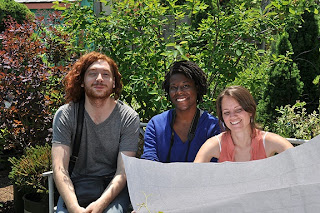



 A big thank you to Donna Sharrett for lending her expertise in planning and preparing the garden!
A big thank you to Donna Sharrett for lending her expertise in planning and preparing the garden!
Check out our new website! 601Tully.syr.edu
601 Tully is a center for engaged practice in Syracuse, NY developed by artist and professor Marion Wilson with a rotating collaborative team of 54 students and neighbors and Anda French of French 2Design. It's a site for meaningful exchange between artists, community members, and scholars in the co-production of culture.
601 Tully includes a contemporary art space, a public events space, a bookstore, a teaching garden, and Recess Cafe West.
In 2009, Wilson purchased the condemned two-story home and local drug hub, and throughout five semesters, Wilson's design/build class re-zoned, designed, renovated and now sustains the physical and programmatic aspects of 601 Tully. The collaborative team has consisted of artists, architects, environmentalists, Fowler High School students, Green Train Workforce, neighbors, and the occasional passerby.
601 Tully is made possible by the generous support of the Syracuse University School of Education, The Kauffman Foundation, The Near West Side Initiative, Imagining America, Home HeadQuarters Inc., Say Yes to Education, and National Grid.
Find us on Facebook!

Serra is considered a part of Postmodernism, and post-minimalism/process art (process and materials made explicit in final product), objects being about what they are: wood is wood, steel is steel, they are aggressively their material. Their construction is also true to their material. Things like joints, clips, gluing, welding, etc. falsify the impression of the real balance and weight of the materials. Serra’s work forces itself uncomfortably on the viewer. They dictate paths around them, incite fear and danger. The steel walls overpowers anyone in range. I don’t think this aggressive nature of the work would be ideal in a community garden, but, I think we can take cues from his unapologetic approach to creating. The materials we find and utilize will be unapologetically themselves, and, if we tie in this aesthetic with the permaculture, the raised garden beds and placement will be designed with the permaculture ideology in mind. I like that the ramp largely cuts into the garden area, because it already brings to mind some of Serra’s work, in that it is defensively itself; it forces the viewer to deal with its presence, to walk around it, etc.
If Serra’s goal was to force the viewer to deal with his artwork in a public space, and he aggressively pursued and designed that goal, and we can take from him that if our goal is to provide a comfortable sitting area/garden for the community, then we will pursue that as unapologetically as he did his goals, and the materials we use will be true to their own materiality.
The visual tie between Serra’s work and permaculture gardening can also be seen in the raised bed gardens.Many of Serra’s pieces look like some of the spiral or keyhole gardens that have been scaled up and stripped of their foliage and dirt. Even if we don’t fully utilize the benefits of keyhole & spiral gardens, I like the aesthetic of them, and how they relate to Serra’s sculptures. Also, Serra's drawings reminded me of vertical gardens, which I think would be a great way to add privacy to the west side of the lot, between the building and our neighbor.
Permaculture: sustainability, low maintenance, little waste, overall planning to solve problem (bigger picture), allowing the land and plants/life to do what they naturally do (growing patterns, etc.) and having that feed into other parts of the implemented design.
Permaculture is an approach to designing human settlements and agricultural systems that are modeled on the relationships found in natural ecologies. Permaculture is sustainable land use design. This is based on ecological and biological principles, often using patterns that occur in nature to maximize effect and minimize work. . Elements in a system are viewed in relationship to other elements, where the outputs of one element become the inputs of another. Within a Permaculture system, work is minimized, "wastes" become resources, productivity and yields increase, and environments are restored. Permaculture principles can be applied to any environment.
A link for an image-only powerpoint is here.
A PDF on keyhole gardens is here.



